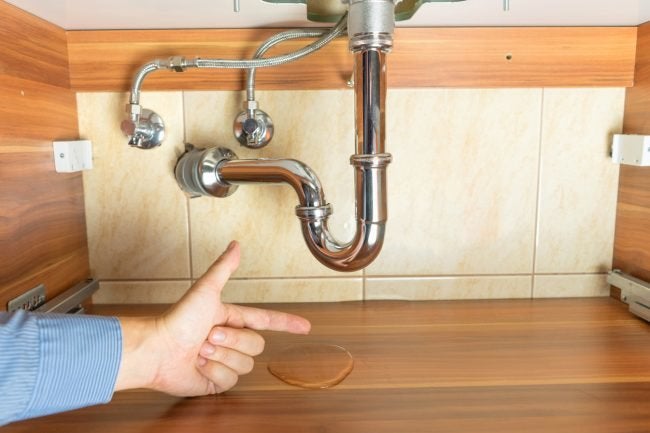Overview To Water Leak Detection In The House
Overview To Water Leak Detection In The House
Blog Article
The publisher is making a few good observations regarding Leaking water lines overall in this great article in the next paragraphs.

Early detection of leaking water lines can mitigate a potential catastrophe. Aside from saving you money, it will reduce the irritation and disappointment. The moment you find a leak, calling your plumber for fixings is the most effective remedy. Some little water leaks may not be noticeable. If you can not find it with your naked eyes, here are some hacks that aid.
1. Take A Look At the Water Meter
Every house has a water meter. Examining it is a surefire manner in which assists you find leaks. For beginners, switch off all the water resources. Make sure nobody will flush, use the faucet, shower, run the cleaning machine or dishwashing machine. From there, go to the meter as well as watch if it will certainly alter. Considering that no one is using it, there ought to be no motions. That indicates a fast-moving leak if it moves. If you spot no changes, wait a hr or two and also examine back again. This means you may have a sluggish leak that could also be below ground.
2. Inspect Water Consumption
If you detect sudden modifications, in spite of your usage being the very same, it indicates that you have leaks in your plumbing system. An unexpected spike in your bill shows a fast-moving leak.
On the other hand, a constant increase each month, despite having the same practices, reveals you have a slow-moving leakage that's additionally gradually rising. Call a plumber to completely check your residential or commercial property, specifically if you feel a cozy area on your floor with piping underneath.
3. Do a Food Coloring Examination
When it comes to water intake, 30% originates from bathrooms. Examination to see if they are running effectively. Decrease specks of food shade in the storage tank and wait 10 mins. There's a leakage between the container and dish if the shade in some way infiltrates your bowl during that time without flushing.
4. Asses Outside Lines
Don't fail to remember to check your exterior water lines also. Should water permeate out of the connection, you have a loosened rubber gasket. One small leakage can lose bunches of water and also spike your water bill.
5. Inspect as well as Examine the Circumstance
Homeowners ought to make it a habit to examine under the sink counters and also inside closets for any kind of bad odor or mold and mildew growth. These two warnings suggest a leak so prompt focus is called for. Doing regular assessments, even bi-annually, can conserve you from a significant issue.
Examine for discolorations as well as weakening as a lot of pipelines and devices have a life expectations. If you believe dripping water lines in your plumbing system, don't wait for it to rise.
Early discovery of dripping water lines can reduce a potential catastrophe. Some little water leakages might not be visible. Checking it is a surefire means that helps you uncover leakages. One small leakage can lose bunches of water and spike your water expense.
If you suspect dripping water lines in your plumbing system, do not wait for it to intensify.
WARNING SIGNS OF WATER LEAKAGE BEHIND THE WALL
PERSISTENT MUSTY ODORS
As water slowly drips from a leaky pipe inside the wall, flooring and sheetrock stay damp and develop an odor similar to wet cardboard. It generates a musty smell that can help you find hidden leaks.
MOLD IN UNUSUAL AREAS
Mold usually grows in wet areas like kitchens, baths and laundry rooms. If you spot the stuff on walls or baseboards in other rooms of the house, it’s a good indicator of undetected water leaks.
STAINS THAT GROW
When mold thrives around a leaky pipe, it sometimes takes hold on the inside surface of the affected wall. A growing stain on otherwise clean sheetrock is often your sign of a hidden plumbing problem.
PEELING OR BUBBLING WALLPAPER / PAINT
This clue is easy to miss in rooms that don’t get much use. When you see wallpaper separating along seams or paint bubbling or flaking off the wall, blame sheetrock that stays wet because of an undetected leak.
BUCKLED CEILINGS AND STAINED FLOORS
If ceilings or floors in bathrooms, kitchens or laundry areas develop structural problems, don’t rule out constant damp inside the walls. Wet sheetrock can affect adjacent framing, flooring and ceilings.
https://www.servicemasterbyzaba.com/blog/how-to-detect-water-leakage-in-walls/

Do you enjoy reading about Detecting hidden plumbing leaks? Post a remark down the page. We would be delighted to hear your thoughts about this post. We hope that you come back again in the near future. Kindly take the opportunity to share this post if you enjoyed it. Thank you for your time. Visit us again soon.
Report this page